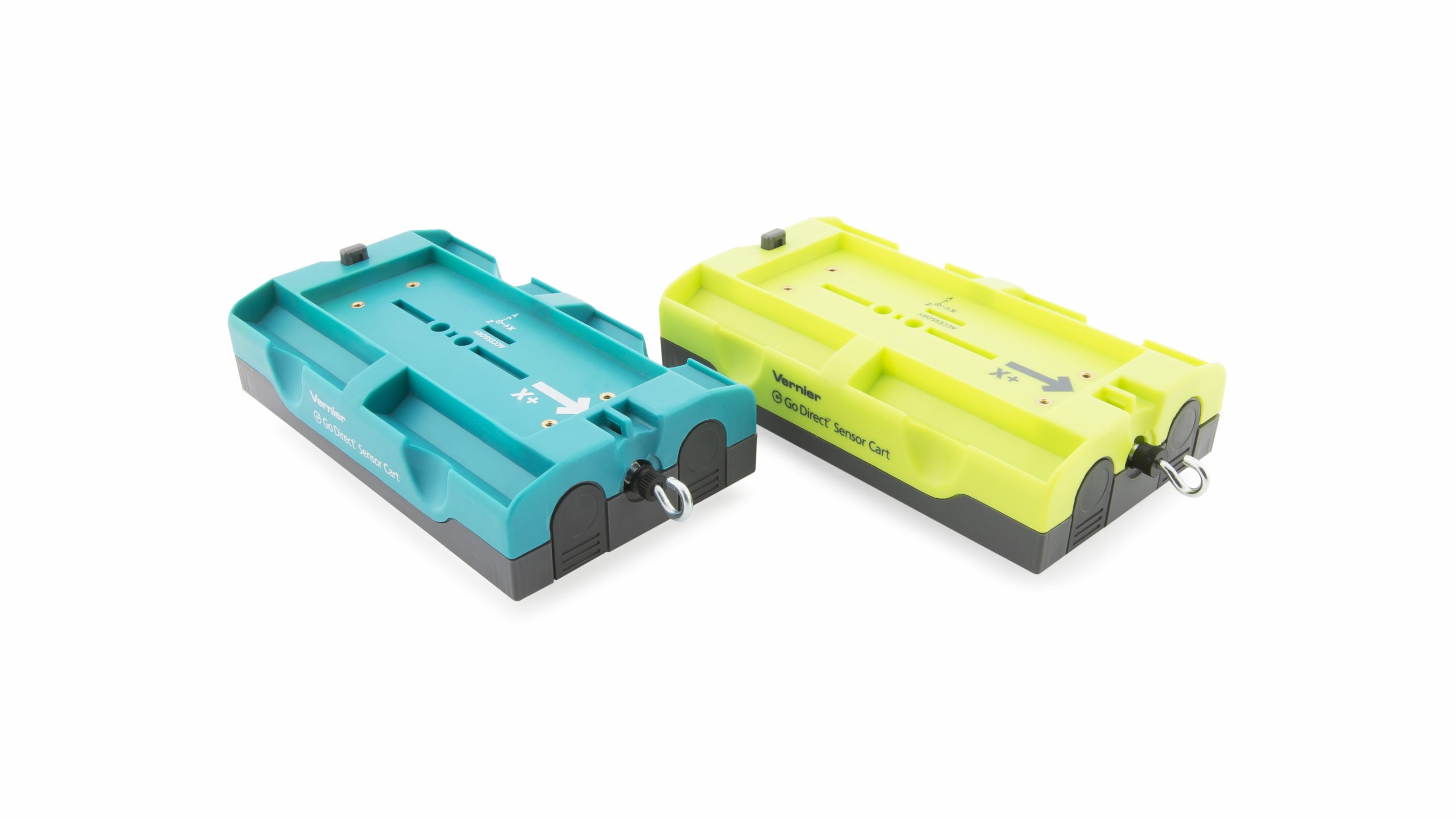Specifications and User Guide for
Go Direct® Sensor Cart (GDX-CART-Y) and
Go Direct® Sensor Cart (GDX-CART-G)
The Go Direct Sensor Cart is a dynamics cart with in-built position, force and acceleration sensors.

Each dynamics cart has built-in:
- Encoder wheel to report position
- 3-axis accelerometer to measure independent acceleration
- 50 N force sensor to measure push and pulls
- Mass trays for changing total mass
- Plunger for collision and impulse studies
- Low friction wheels for uniform motion
Go Direct Sensor Cart is available in green and yellow in order to facilitate classroom discussions about collisions. The two colors are designed to be distinguishable by many color-blind viewers. Data column names have a suffix of “Y” or “G” so that you can tell the carts apart in a data table. When only one cart is used, disregard the suffix.
What’s Included with each cart:
- Go Direct Sensor Cart
- Force Sensor Hook
- Flat-top Rubber Bumper for Force Sensor
- Anti-Roll peg
- 4 empty Collision Tabs
- Micro USB Cable
TROUBLESHOOTING
Primary Test:
- Connect to the cart in Graphical Analysis, Graphical Analysis Pro or LabQuest App.
- Enable Position and Force.
- View meter readouts of position and force in Graphical Analysis.
- Roll cart on table in direction of force sensor. Does position reading increase?
- Push on force sensor. Does sensor respond with a negative reading?
Minimum software version: Graphical Analysis version 4.3. LabQuest App version 2.8.4.
RELATED ARTICLES
What are the dimensions of the plastic dynamics carts?
Can I use the Sensor Cart to measure simple weights and masses?
How do I replace the wheels on a Go Direct Sensor Cart?
Sensor cart position reading decreases when cart is moved in the +x direction.
Why does my Sensor Cart force sensor not work when I attach something to the top of the cart?
What are the specifications for the screw that secures the battery cover on a Go Direct Sensor Cart?
What are the dimensions and threads of the mounting holes on Go Direct Sensor Carts?
When collecting force data, why aren't the measured impulses synced?
Go Direct Sensor Cart Troubleshooting and FAQs
SPECIFICATIONS
Position resolution 0.25 mm, displaying to nearest 1 mm
Nominal Mass 275 g excluding accessories
Accessory Port Available for future expansion
Force response time 1 ms
Force range ±50 N
Acceleration range ±160 m/s2
USB specification USB 2.0 full speed
Wireless specification Bluetooth v4.2
Maximum wireless range 30 m (unobstructed)
Dimensions
- Length: 16.6 cm, not including accessories mounted to the force sensor
- Width: 9.6 cm
- Height: 4.7 cm
Battery 650 mAh Li-Poly Rechargeable (Go Direct® 650 mAh Replacement Battery (GDX-BAT-650))
Battery life (single full charge) ~10 hours continuous data collection
Battery life (long term) ~300 full charge cycles (several years depending on usage)
CALIBRATION
Position (m)
The position channel does not need to be calibrated, nor can it be calibrated. The Position channel can be zeroed. This is useful to establish a zero position on a track. Do not pick up the cart after zeroing to avoid disturbing the zero. The Position Sensor can also be reversed. This is useful when using two carts in collision mode with force sensors facing one another. To put the two carts on the same coordinate system, reverse the direction of the position and force sensors on one cart, and zero the cart positions with the carts in contact.
Force (N)
This sensor is factory calibrated. If you would like to calibrate the force sensor yourself, use a two-point calibration: no force applied and a known force applied. It is easiest to simply hang a mass from the hook. We recommend a 1 kg mass. Do not exceed the maximum of 50 N during calibration.
The Force Sensor can be zeroed. This is useful after calibration to remove the weight of the hook. The Force Sensor can also be reversed so that push is positive.
X-, Y-, and Z-Acceleration (m/s2)
This sensor is factory calibrated.
The Go Direct Sensor Cart can be used in a variety of experiments:
- Collect position, velocity, and acceleration data as the cart rolls freely up and down an incline.
- Observe collisions between two carts, test for the conservation of momentum, or measure energy changes during different types of collisions.
- Investigate the relationship between force, mass, and acceleration.
- Examine the energies involved in simple harmonic motion.
- Measure a cart’s momentum change and compare it to the impulse it receives.
BATTERY TROUBLESHOOTING
If the sensor can be turned on when connected by USB but not when disconnected from USB, it is likely that the battery just needs to be charged. In this case, charge the sensor for several hours and try again. If, however, the sensor won’t turn on regardless of whether the USB cable is connected or not, and you are confident that the USB cable is good by having tested it on another sensor, then the battery has likely reached its end of life and can no longer hold a charge. In this state, the sensor cannot be used even if connected by USB, so the battery will need to be replaced. The rechargeable battery in this sensor is covered by a one year warranty but should last two to five years in typical use. Note that if the battery is less than one year old and the sensor cannot be turned on even when connected by a working USB cable, another possibility is that the USB port is bad. In this case, contact Vernier technical support for assistance.
RELATED VERNIER PRODUCTS
- Dynamics Cart and Track System with Go Direct® Sensor Carts (DTS-GDX)
- Go Direct® Sensor Cart Accessory Kit (GDX-CART-AK)
- Dynamics Cart and Track System (DTS)
- Go Direct® Sensor Cart Charge Station (GDX-CART-CRG)
